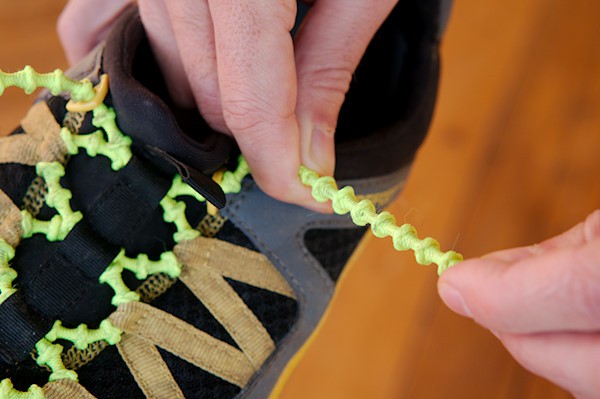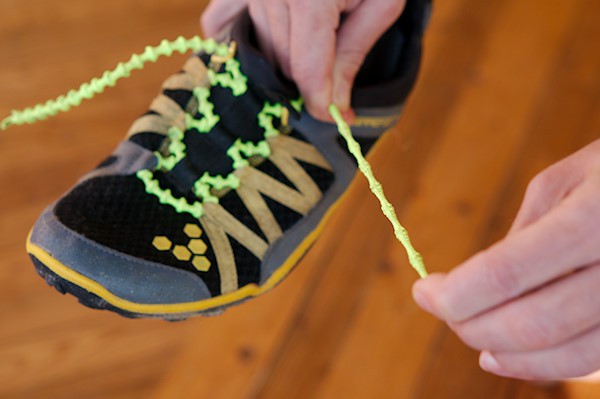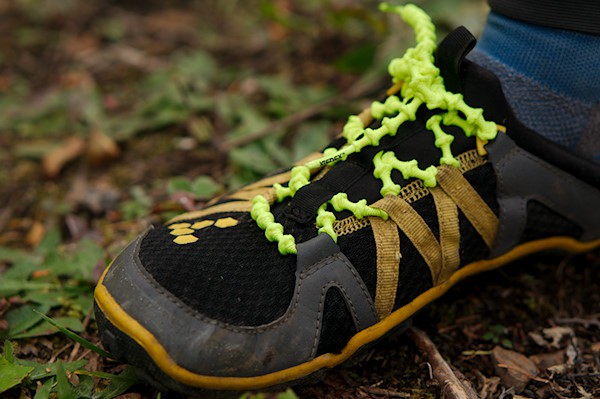This summer I wrote an article about my favorite shoe laces, the New Balance Sure Lace. What makes the Sure Lace design special is the bubble or sausage-link shape. This special shape locks the lace in place through the eyelets and makes the knot highly slip-resistant, creating a very secure lacing system.
In the comments of that article, one of my readers asked if I had ever heard of Xtenex laces. I hadn't, so I thought I would check them out and see what they are all about.
Xtenex laces take the bubble (or what they call knots) concept to a whole new level. What exactly is this whole new level I am talking about? In a word... elasticity.

While the designs of the Xtenex and New Balance laces may look similar, their function is completely different. What New Balance has achieved with their design is security, or a shoe lace that locks in place and stays tied. What Xtenex has achieved with their design is what I would call ergonomics or customizability and arguably a better foot/shoe interface. Xtenex does this in two ways:
- By enabling you to customize the tension/tightness of the lace along the entire length of the shoe.
- By enabling the shoe to expand elastically under load while maintaining a secure fit.

Customized Tension
We all have different shaped feet. If you take 10 people with a size nine foot, no two will be the same. In an ideal world, footwear would be custom made to each persons exact specifications. Because we don't live in an ideal world, we have to find work-arounds to get a fit that is optimum for our needs.
In theory, laces help to provide customizability. If your feet are wide you lace your shoes looser, and if your feet are narrow, you lace them tighter. It is the variability of the lace opening that allows for customizing the fit.
The problem with standard lace designs however is that if you want the lacing to be wider towards the toebox and narrower towards the ankle (or whatever combination suits the shape of your foot), it isn't easy to achieve. Sure there are some tricks you can use like skipping eyelets and such, but I have found them to be less than ideal. Laces always tend settle out at some average as they slip through the eyelets and equalize the tension across the entire lace.
What would be nice is to be able to set the tension/width across each pair of eyelets - and have the fit stay that way. Xtenex has more-or-less achieved this, and here is how it works:
- The knots in Xtenex laces are wide enough that they don't slip through the eyelets.
- You set the tension at each eyelet, and the lace is locked in place at that tension.
- Once the shoe is laced to your liking, you shouldn't have to change it again.
Here is a quick video that shows how this works:
Elasticity
Feet are dynamic - they are never the same shape. They expand under load, and change shape as they absorb shock, provide balance, and propel us forward. Footwear is not as dynamic as our feet, and can often be constraining. The materials used often don't stretch, laces usually don't stretch, and people often tie them tight to get a secure, no-slip fit.
Xtenex laces are elastic, which means that they help the shoe to expand and contract as your foot changes shape within the shoe. Yes, elastic laces are not new. What is innovative in the Xtenex design however is the fact that you can have both a custom fit (as described above), and that those customizations will be maintained no matter what shape your foot decides it wants to be.
So, if you need extra width in the forefoot and a narrow fit near the ankle, you can set that up with the Xtenex laces, and that configuration will remain throughout all the dynamic movements of your foot. This, in my mind, fits very well with the minimalist philosophy of footwear: Xtenex laces enable your feet to work in a more natural fashion, and they do their best to get out of your way.
Xtenex in Action

Xtenex sent me two pairs of laces for review: the Xh200 Tapered, and the X300 Flared. The difference between the 200 and 300 series is the size of the knot. The 300 series has big knots that are highly resistant to slipping through the eyelets (depending on the size of the eyelets). The 200 series has smaller knots for smaller eyelets or less aggressive use cases (i.e. everyday use). I put the X300 on a pair of VIVOBAREFOOT Breatho Trails (which have large eyelets), and the Xh200 on my Inov-8 TrailRoc 150s (which have small eyelets).
Getting a comfortable fit took a little time. The first time I installed the laces and went for a run, my feet felt sore afterwards. It turns out that even though I tried to not lace them too tight, they were too tight. The elastic of these laces is stiffer compared to other elastic laces I have used. It took a couple runs and some fine tuning to get the fit right. Once the fit was dialed-in, I didn't have to think about it any more. Now they just slip on and away I go - the fit is exactly the same every time (a feature triathletes would probably love).
I have found the Xtenex laces to be especially nice on the Inov-8 TrailRoc 150, as the fabric used for the uppers has no stretch whatsoever. In the past, to accomodate for the lack of stretch, I had to keep the lacing relaxed or loose. Now - thanks to elastic laces - I am able to get a more secure fit and more comfort because of the added stretch. While I liked the Inov-8 shoes a lot as it they were, I like them even more with the Xtenex laces in them.
On the VIVOBAREFOOT Breatho Trails, Xtenex laces didn't provide as much of a noticeable difference. The uppers are softer and stretchier, and the gusseted design (as opposed to having a tongue) makes for a more relaxed fit. That being said, they still work great and I really like the fact that I never have to tie them, and they never come undone.
As a side note, kids will also love these. My kids almost always choose shoes that they don't have to tie. With Xtenex laces you can easily make any shoe a slip-on. My youngest daughter now pines after my shoe laces.
Concluding Thoughts
So while I sang the praises of the New Balance Sure Lace (I still think they are a great lace), I am now thinking that I actually like Xtenex laces better. I like the ability to really customize the fit of shoes to my feet. I also love the extra stretch they add, which enables more natural foot function. What is there not to like?
Have you tried Xtenex shoe laces before? What do you think?
